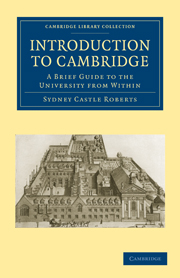V - POSTGRADUATE
Published online by Cambridge University Press: 10 November 2010
Summary
In every year about 1400 undergraduates are admitted to the degree of Bachelor of Arts in the University of Cambridge. What becomes of them? The majority leave Cambridge; a smaller number remain in residence as bachelors and continue their studies. This may be done with a variety of objects. The man who has been placed in the First Class of a Tripos may be looking towards an academic career. For such a man his college is generally glad to extend the period of the tenure of his scholarship, and he may elect to read for another Tripos; or he may be a candidate for one of the many scholarships or prizes offered by the university and designed to enable a student to undertake a year's research in some special branch of his subject; or he may officially become a “Research Student”, that is, he may, with the approval of the Degree Committee of a Faculty and of the Board of Research Studies, become a candidate for a “research” degree to be obtained by means of a dissertation on a subject proposed by him and approved by the board. Such a candidate is placed under a supervisor in the university who directs his work; he may apply for the degree of Doctor of Philosophy (Ph.D.) for which two or three years’ work is required; for the degree of Master of Science (M.Sc.) or Master of Letters (M.Litt.) only one or two years’ work is necessary.
- Type
- Chapter
- Information
- Introduction to CambridgeA Brief Guide to the University from Within, pp. 92 - 100Publisher: Cambridge University PressPrint publication year: 2009First published in: 1934



